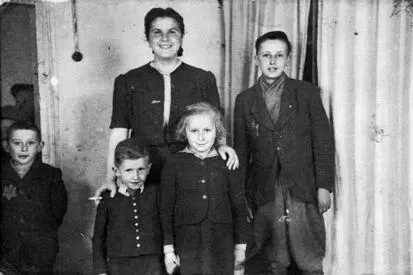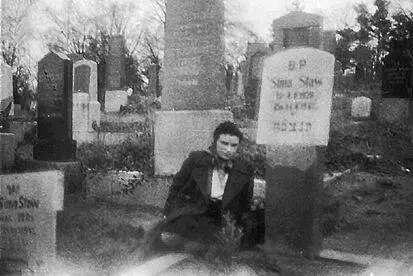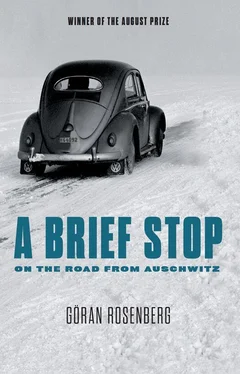The last letter from Alingsås in my hands is dated August 9, 1946, and opens on a despondent note despite the fact that Haluś has finally found her way from Łódź in Poland to Bergen-Belsen in Germany, and the horizon ought reasonably to look brighter:
I find it hard to begin writing this letter to you as I had so much wanted to have concrete news for you, but everything here has reached deadlock for now. I made a big mistake in my application to the W.J.C. [World Jewish Congress] by referring to you as my fiancée.
If you had signed yourself Staw-Rozenberg in your first letter, I would have known how to go about it. As I wrote to you in my earlier letters, do not think of my exertions, stay watchful and on your guard where you are.
August 22, 1946, brings an icy response from the State Aliens Commission in Stockholm to your application for an entry visa for the woman you unwisely refer to as your fiancée (you already know that’s not enough, as only married couples get permission).
On that very same day, a woman going by the name of Hella Cwaighaft arrives in Helsingborg from Bergen-Belsen and is put into three weeks’ quarantine at Landskrona Citadel. Description: height five feet two inches, hair black, eyes brown, face shape oval, nose straight, age twenty. When registering, she gives her proper name, Hala Staw, and applies for a residence permit and a foreigner’s passport. The reason given for the former is that she wants to join her fiancé in Sweden. The reason given for the latter is that she no longer wishes to be a Polish citizen.
On September 12, 1946, Hala Staw moves in with David Rosenberg at Pension Friden in Alingsås. On September 19, 1946, she’s hired as a seamstress at Sveriges Förenade Linnefabriker at a wage of fifty kronor a week. On February 23, 1947, she marries the man who is to be my father at the synagogue in Gothenburg.
The next letter I hold in my hand is dated August 2, 1947, and opens “My dearest Halinka, I got to Södertälje at seven in the evening.”

So perhaps it’s appropriate to say something about how this has happened, which is to say something about yet another improbable road from Auschwitz. I don’t intend to say very much; like you I don’t want to bore my readers, and even miracles can get tedious, but something must perhaps be said, nevertheless.
After the selection for the gas chambers on the ramp in Auschwitz-Birkenau in August 1945, there are four members of the Staw family left, four sisters to be precise, among whom Hala is the youngest and Bluma the eldest. Between them come Bronka and Sima. There are photos preserved of sister Sima in the Łódź ghetto, tiny miniature prints, one centimeter by two, taken to be hidden in the growing archive of documents, jottings, statistics, and photographs that the Jewish ghetto administration is building up in a special room with a special entrance in the house at 4 Kościelny Square, and which after the liquidation of the ghetto is saved for posterity by a man named Nachman Zonabend, who belongs to a small group of a few hundred Jews left behind to clear up the human and inhuman remains of the liquidated ghetto’s residents. It’s a repulsive job among dead bodies and excrement, and requires special rations of spirits for non-Jews, and special Jews for the most repulsive tasks, but the work allows Nachman Zonabend to survive in the ruins of the ghetto until liberation in January 1945, and the miniature pictures of Sima survive with him. In the summer of 1945, Nachman Zonabend is brought to Sweden by the Red Cross along with two of his brothers, one of whom much later becomes a neighbor of ours on the first floor of a modern block of apartments in a suburb of Stockholm. Through Nachman Zonabend, the pictures of Sima come into the hands of the woman who is to be my mother and are stashed in the back of the frame that holds the only existing photo of my paternal grandfather, Gershon.
The reason the ghetto archive keeps pictures of Sima is that she works in the ghetto administration’s orphanage, which is one of the many ghetto activities of which a photographic record is kept for posterity. The photos of her look as if they are all taken on the same day: in all of them she is wearing a dark, short-sleeved, jacketlike blouse over a pale top, and her dark blond hair is combed lightly back into a loose bun at the nape of her neck.
Only the situations and poses change.
Sima assisting at the examination of a naked boy on a chair, in front of a woman in white, the boy looking into the camera.
Sima with a young girl getting treatment in a dentist’s chair, flanked by two women in white, the girl’s face in profile, gently held still by two hands.
Sima at a desk, against the bright light from a window, reflections from sheets of paper and the desktop softly lighting her face, and through the overexposed windowpane a searching look from a boy whose nose scarcely reaches the windowsill. A photographer with a camera is hardly an everyday sight in the ghetto.
Sima standing behind two children, a boy and a girl, her hands on their shoulders, a cigarette in her right hand. The boy is said to be my cousin Obadja. Also in the picture are two older boys with big Stars of David sewn on the right lapels of their skimpy jackets.

One last photograph of a woman, very blurred, and in fact not of Sima but of the woman who is to be my mother. It’s taken in the summer of 1945 in the Jewish cemetery in the city of Słupsk, which until recently was a German city called Stolp, and where the Jewish cemetery was filled mainly with men who had given their lives for Das Vaterland in the First World War. In the last week of June 1945, a month and a half after the German surrender, Sima Staw, born August 2, 1920, is buried here. In the blurred photo, the woman who is to be my mother is sitting at her grave.
I’m amazed that the Nazis have left any part of the cemetery untouched (the oldest part is confiscated by the Gestapo in 1942, who turn the chapel of rest into accommodations for civilian forced labor), that they have not taken the opportunity to obliterate the traces of those already dead as well.
In the blurry picture, row upon row of tall gravestones.
When, much later, my sister Lilian tries to find Sima’s grave, there’s no grave to be found. In the 1970s, the Jewish cemetery in Słupsk is razed to the ground. The gravestones are turned into fragments and building material, the cemetery into something else.

On the ramp in Auschwitz-Birkenau, the Staw sisters are categorized as not fully processed human reserves and a few days later transported onward to Stutthof, a concentration camp near Danzig on the Baltic coast. In August and September 1944, 11,464 not fully processed prisoners are transported from Auschwitz to Stutthof (Polish researchers have unearthed the Germans’ lists and counted up the numbers), some 7,000 of them women from the liquidated ghetto in Łódź. The full processing in Stutthof costs most of them their lives. Stutthof too is surrounded by an archipelago of slave camps, but most of the prisoners from Łódź via Auschwitz die of starvation and sickness in the main camp. It also has a primitive gas chamber, about 175 cubic feet in size (still standing), in which a thousand or more people, most of them women, are murdered with Zyklon B between August and November 1944. Others are murdered in a railroad car on a siding leading to the crematorium. Others are murdered by phenol injection or shot in the back of the head in the crematorium building itself. As the Eastern Front draws nearer, the Stutthof slave labor camps are evacuated, and eventually the main camp as well. Of the 15,000 who are evacuated, 3,000 survive. On January 31, 1945, between 3,000 and 4,000 prisoners from Stutthof are herded onto the beach near Palmnicken (today Yantarny in the Russian enclave of Kaliningrad) and driven into the sea. Fifteen survive.
Читать дальше















